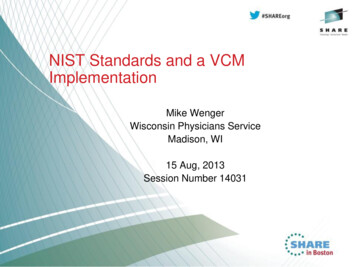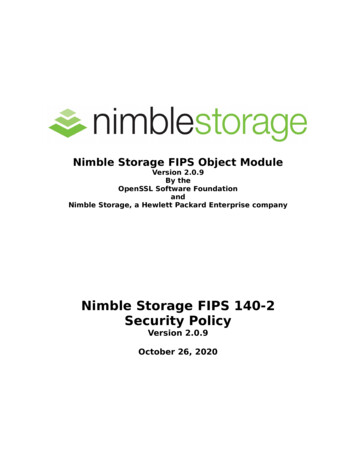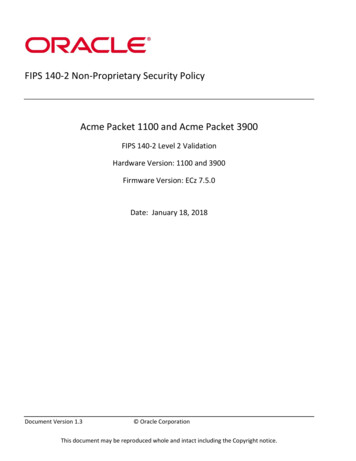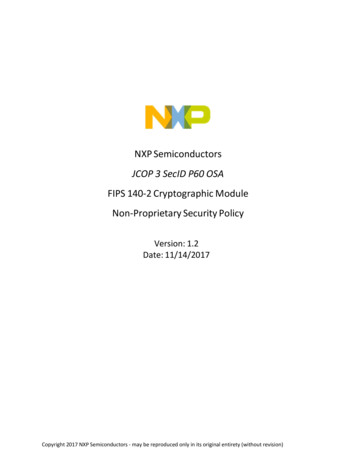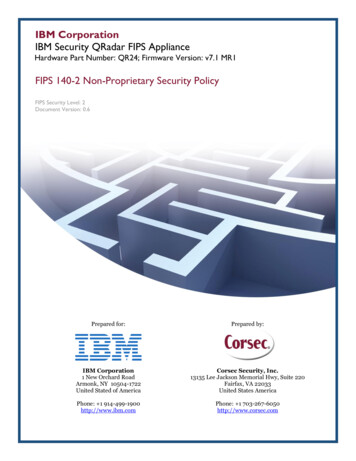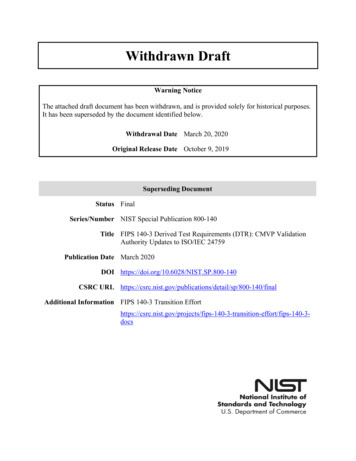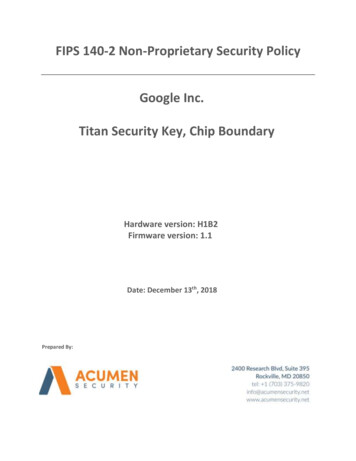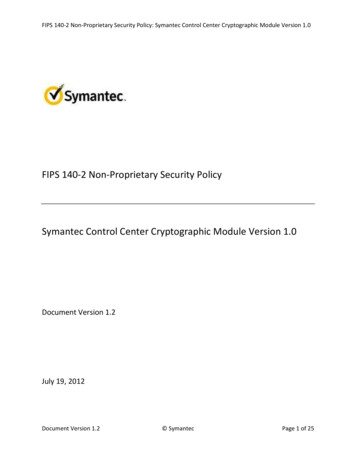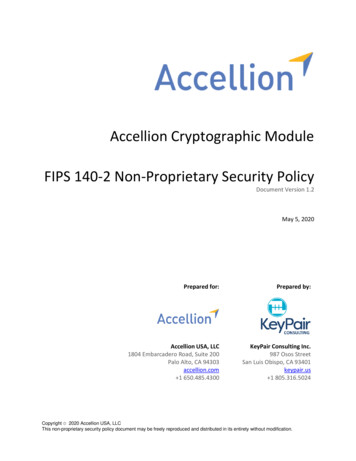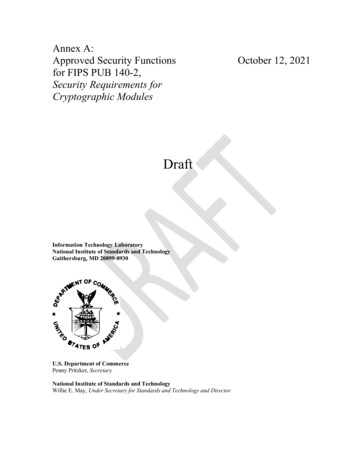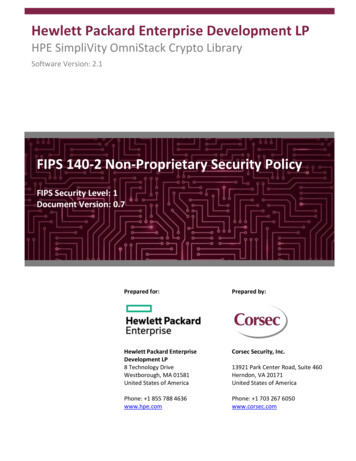
Transcription
Hewlett Packard Enterprise Development LPHPE SimpliVity OmniStack Crypto LibrarySoftware Version: 2.1FIPS 140-2 Non-Proprietary Security PolicyFIPS Security Level: 1Document Version: 0.7Prepared for:Prepared by:Hewlett Packard EnterpriseDevelopment LP8 Technology DriveWestborough, MA 01581United States of AmericaCorsec Security, Inc.Phone: 1 855 788 4636www.hpe.comPhone: 1 703 267 6050www.corsec.com13921 Park Center Road, Suite 460Herndon, VA 20171United States of America
FIPS 140-2 Non-Proprietary Security Policy, Version 0.7June 25, 2018Table of Contents1.Introduction .41.1Purpose .41.2References .41.3Document Organization .42.HPE SimpliVity OmniStack Crypto Library .52.1Overview .52.2Module Specification .62.2.1 Physical Cryptographic Boundary .82.2.2 Logical Cryptographic Boundary .92.3Module Interfaces . 102.4Roles and Services. 112.5Physical Security. 132.6Operational Environment . 132.7Cryptographic Key Management . 132.8EMI / EMC . 182.9Self-Tests . 182.9.1 Power-Up Self-Tests. 182.9.2 Conditional Self-Tests . 182.9.3 Critical Functions Self-Tests . 192.9.4 Self-Test Failure Handling . 192.10 Mitigation of Other Attacks . 193.Secure Operation . 203.1Installation . 203.2Initialization . 203.3Operator Guidance . 203.3.1 Crypto Officer Guidance . 203.3.2 User Guidance. 213.3.3 General Operator Guidance. 213.4Additional Guidance and Usage Policies . 213.5Non-FIPS-Approved Mode . 224.Acronyms . 23List of TablesTable 1 – Security Level per FIPS 140-2 Section .6Table 2 – FIPS-Approved Cryptographic Algorithms .7Table 3 – FIPS 140-2 Logical Interface Mappings . 10Table 4 – Operator Services. 11HPE SimpliVity OmniStack Crypto Library 2018 Hewlett Packard Enterprise Development LPThis document may be freely reproduced and distributed whole and intact including this copyright notice.Page 2 of 25
FIPS 140-2 Non-Proprietary Security Policy, Version 0.7June 25, 2018Table 5 – Cryptographic Keys, Cryptographic Key Components, and CSPs . 14Table 6 – Acronyms . 23List of FiguresFigure 1 – HPE SimpliVity OmniCube.5Figure 2 – Host Server Physical Block Diagram .9Figure 3 – Logical Block Diagram . 10HPE SimpliVity OmniStack Crypto Library 2018 Hewlett Packard Enterprise Development LPThis document may be freely reproduced and distributed whole and intact including this copyright notice.Page 3 of 25
FIPS 140-2 Non-Proprietary Security Policy, Version 0.71.Introduction1.1PurposeJune 25, 2018This is a non-proprietary Cryptographic Module Security Policy for the HPE SimpliVity OmniStack Crypto Library(software version: 2.1) from Hewlett Packard Enterprise Development LP (HPE). This Security Policy describes howthe HPE SimpliVity OmniStack Crypto Library meets the security requirements of Federal Information ProcessingStandards (FIPS) Publication 140-2, which details the U.S. and Canadian government requirements forcryptographic modules. More information about the FIPS 140-2 standard and validation program is available onthe National Institute of Standards and Technology (NIST) and the Communications Security Establishment (CSE)Cryptographic Module Validation Program (CMVP) website at http://csrc.nist.gov/groups/STM/cmvp.This document also describes how to run the module in a secure FIPS-Approved mode of operation. This policywas prepared as part of the Level 1 FIPS 140-2 validation of the module. The HPE SimpliVity OmniStack CryptoLibrary is also referred to in this document as the cryptographic module or the module.1.2ReferencesThis document deals only with operations and capabilities of the module in the technical terms of a FIPS 140-2cryptographic module security policy. More information is available on the module from the following sources: The HPE website (www.hpe.com) contains information on the full line of products from HPE. The CMVP website 0-1/140val-all.htm) containscontact information for individuals responsible for answer technical or sales-related questions for themodule.1.3Document OrganizationThe Security Policy document is organized into two (2) primary sections. Section 2 provides an overview of thevalidated modules. This includes a general description of the capabilities and the use of cryptography, as well asa presentation of the validation level achieved in each applicable functional areas of the FIPS standard. It alsoprovides high-level descriptions of how the modules meet FIPS requirements in each functional area. Section 3documents the guidance needed for the secure use of the module, including initial setup instructions andmanagement methods and policies.HPE SimpliVity OmniStack Crypto Library 2018 Hewlett Packard Enterprise Development LPThis document may be freely reproduced and distributed whole and intact including this copyright notice.Page 4 of 25
FIPS 140-2 Non-Proprietary Security Policy, Version 0.7June 25, 20182.HPE SimpliVity OmniStack Crypto Library2.1OverviewTo meet growing virtual infrastructure requirements, HPE offers hyperconverged infrastructure solutionsdesigned to meet the needs of IT environments from branch offices to enterprises. Hyperconverged infrastructureconsists of a virtual computing platform that combines all IT components and services typically found below thehypervisor into an x86-based “building block”. Designed to create efficiencies in virtual computing environments,hyperconverged infrastructure eliminates the need to manage discrete devices or have specialized training incomponent-level technology (such as SANs1).HPE markets and sells its hyperconverged solutions under the “SimpliVity” brand name. The core technologypowering these solutions includes the OmniStack Virtual Controller, or OVC (a software-based file system withdata optimization, abstracting data from its underlying hardware), and the OmniStack Accelerator Card, or OAC(a purpose-built PCIe2 that offloads global inline deduplication, compression, and optimization processes).HPE packages their hyperconverged infrastructure solution on enterprise-grade x86 platform called the OmniCube(see Figure 1 below). The OmniCube is sold with the HPE software components and the OAC on a 2U server withan Intel Xeon processor and VMware ESXi v5.5 or 6.0 running Ubuntu 14.04.5 LTS3. The OmniCube is available inseveral hardware models that scale for the appropriate workload by offering varying amounts of storage capacity,number of cores, and virtual machine support.Figure 1 – HPE SimpliVity OmniCubeAnother key component of the overall solution is Arbiter. Arbiter is a software agent that is used to break quorumties between federated OmniCube servers. Arbiter is installed on a host server or virtual machine (VM) runningWindows Server 2012 R2.The HPE SimpliVity OmniStack Crypto Library supplies the cryptographic functionality necessary to support TLS4secured communications between OVC and Arbiter. In this document, the OVC and Arbiter software components(both of which link to the HPE SimpliVity OmniStack Crypto Library for cryptographic service support) will bereferred to collectively as the “calling application”.1SAN – Storage Area NetworkPCIe – Peripheral Computer Interconnect Express3LTS – Long Term Support4 TLS – Transport Layer Security2HPE SimpliVity OmniStack Crypto Library 2018 Hewlett Packard Enterprise Development LPThis document may be freely reproduced and distributed whole and intact including this copyright notice.Page 5 of 25
FIPS 140-2 Non-Proprietary Security Policy, Version 0.7June 25, 2018The HPE SimpliVity OmniStack Crypto Library is validated at the FIPS 140-2 Section levels shown in Table 1.Table 1 – Security Level per FIPS 140-2 SectionSection2.2Section TitleLevel1Cryptographic Module Specification12Cryptographic Module Ports and Interfaces13Roles, Services, and Authentication14Finite State Model15Physical Security6Operational Environment17Cryptographic Key Management18Electromagnetic Interference/Electromagnetic Compatibility (EMI/EMC)19Self-tests110Design Assurance111Mitigation of Other AttacksN/AN/AModule SpecificationThe HPE SimpliVity OmniStack Crypto Library is a software module with a multiple-chip standalone embodiment.The overall security level of the module is 1.The module consists of a cryptographic library based on the OpenSSL FIPS Canister (OpenSSL FIPS Object Moduleversion 2.0.13). It is compiled into object form (fipscanister.o for Linux-based systems, fipscanister.lib onWindows-based systems) and then statically linked to an instance of the OpenSSL version 1.0.2k libcrypto libraryat build-time. The OpenSSL libcrypto library is then linked to the calling application (dynamically linked on Linux,statically linked on Windows), which is loaded into memory for execution by the operating system loader.For FIPS 140-2 conformance testing, the module was tested and found compliant when running on the followingoperational environments:HPE SimpliVity OmniStack Crypto Library 2018 Hewlett Packard Enterprise Development LPThis document may be freely reproduced and distributed whole and intact including this copyright notice.Page 6 of 25
FIPS 140-2 Non-Proprietary Security Policy, Version 0.7June 25, 2018 OmniCube CN-3400-12bcc appliance with an Intel Xeon E5-2600 V3 Series processor with VMware ESXi6.0.0 hosting a virtual machine running Ubuntu 14.04.5 LTS OS5 (OVC) OmniCube CN-3400-12bcc appliance with an Intel Xeon E5-2600 V3 Series processor with VMware ESXi6.0.0 hosting a virtual machine running Windows Server 2012 R2 OS (Arbiter)The module implements the FIPS-Approved algorithms listed in Table 2 below.Table 2 – FIPS-Approved Cryptographic AlgorithmsCertificate FIPS PUB 4Mode / MethodKey Lengths / Curves/ ModuliUseECB7, CBC8, CTR9128, 192, 256encryption/decryptionNIST SP10 800-38CCCM11128, 192, 256encryption/decryptionNIST SP 800-38DGCM12128, 192, 256encryption/decryptionNIST SP 800-133--symmetric keygeneration-key derivationNIST SP 800-135rev1 SSH15, TLS v1.2#1617#1600CVLNIST SP 800-56AECC#1880#1866DRBG17NIST SP 800-90ACTR-based128, 192, 256deterministic randombit generationHash-basedSHA-1, SHA-224, SHA256, SHA-384, SHA-512deterministic randombit generationHMAC-basedSHA-1, SHA-224, SHA256, SHA-384, SHA-512deterministic randombit generationKPG19NIST-defined Pkey pair generationcurves (P-256 and P-384)PKV20NIST-defined Ppublic key verificationcurves (P-256 and P-384)SigGen, SigVerNIST-defined Pdigital signaturecurves (P-256 and P-384) generation andverification#1311#1300ECDSA18FIPS PUB 186-4CDH16PrimitiveNIST-defined Pshared secretcurves (P-256 and P-384) computation5OS – Operating SystemAES – Advance Encryption Standard7 ECB – Electronic Code Book8 CBC – Cipher Block Chaining9 CTR – Counter10SP – Special Publication11 CCM – Counter with CBC-MAC12 GCM – Galois Counter Mode13 CKG – Cryptographic Key Generation14CVL – Component Validation List15 SSH – Secure Shell16 ECCCDH – Elliptic Curve Cryptography Cofactor Diffie-Hellman17 DBRG – Deterministic Random Bit Generator18 ECDSA – Elliptic Curve Digital Signature Algorithm19KPG – Key Pair Generation20 PKV – Public Key Verification6HPE SimpliVity OmniStack Crypto Library 2018 Hewlett Packard Enterprise Development LPThis document may be freely reproduced and distributed whole and intact including this copyright notice.Page 7 of 25
FIPS 140-2 Non-Proprietary Security Policy, Version 0.7June 25, 2018#3379#3365HMAC21FIPS PUB 198-1SHA-1, SHA-224,SHA-256. SHA-384,SHA-512160, 224, 256, 384, 512messageauthentication#2744#2731RSA22FIPS PUB 186-4SigGen9.31,SigGenPKCS231.5,SigGenPSS24,2048, 3072digital PSS1024, 2048, 3072digital signatureverificationKeyGen9.312048, 3072key pair generationSHA26-1,-message digestKeying option ple-DES27FIPS PUB 180-4SHA-224,SHA-256, SHA-384,SHA-512NIST SP 800-67rev2 TECB, TCBCCAVP28Note1: No parts of the SSH and TLS protocols, other than the KDFs, have been tested by theand CMVP.Note2: The module explicitly disallows the use of SHA-1 when generating digital signatures.Note3: The module employs a CKG method whose resulting symmetric key or generated seed is an unmodified output of the DRBG.The module also implements the following non-Approved algorithm: EC Diffie-Hellman (key agreement: key establishment methodology provides 128 or 192 bits of encryptionstrength)o supports curves P-256 and P-384o allowed per FIPS IG D.8 scenario #3As a software module, the HPE SimpliVity OmniStack Crypto Library has both a logical cryptographic boundary anda physical cryptographic boundary. The physical and logical boundaries are described in Sections 2.2.1 and 2.2.2,respectively.2.2.1 Physical Cryptographic BoundaryAs a software cryptographic module, the module has no physical components. Therefore, the physical boundaryof the cryptographic module is defined by the hard enclosure around the host server on which it runs.The host server hardware, the OmniCube CN-3400-12bcc, consists of a motherboard, a Central Processing Unit(CPU), random access memory (RAM), read-only memory (ROM), hard disk(s), hardware case, power supply, andfans. Other devices may be attached to the hardware appliance such as a monitor, keyboard, mouse, DVD29 drive,printer, video adapter, audio adapter, or network adapter. In the validated configuration, the processor is an IntelXeon processor. Please see Figure 2 for a block diagram the host server and a depiction of the physicalcryptographic boundary.21HMAC – (keyed-) Hashed Message Authentication CodeRSA – Rivest Shamir Adleman23PKCS – Public Key Cryptography Standard24 PSS – Probabilistic Signature Scheme25 SHS – Secure Hash Standard26 SHA – Secure Hash Algorithm27 DES – Data Encryption Standard28CAVP – Cryptographic Algorithm Validation Program29 DVD – Digital Versatile Disc22HPE SimpliVity OmniStack Crypto Library 2018 Hewlett Packard Enterprise Development LPThis document may be freely reproduced and distributed whole and intact including this copyright notice.Page 8 of 25
FIPS 140-2 Non-Proprietary Security Policy, Version 0.7HardwareManagementJune 25, TAControllerLEDs/LCDSerialCPU(s)I/O ntrollerExternalPower SupplyPlaintext dataEncrypted dataControl inputStatus outputCrypto boundaryUSBBIOSPCI/PCIeSlotsKEY:BIOS – Basic Input/Output SystemCPU – Central Processing UnitSATA – Serial Advanced Technology AttachmentSCSI – Small Computer System InterfacePCI – Peripheral Component InterconnectPCIe – PCI expressHDD – Hard Disk DriveDVD – Digital Video DiscUSB – Universal Serial BusRAM – Random Access MemoryFigure 2 – Host Server Physical Block Diagram2.2.2 Logical Cryptographic BoundaryThe module is used by the calling application to provide symmetric cipher operation, digital signature generationand verification, hashing, cryptographic key generation, random number generation, message authenticationfunctions, and secure key agreement/key exchange protocol support. The module is entirely contained within thephysical cryptographic boundary described in Section 2.2.1.FIGURE 3 shows the logical block diagram of the module executing in memory and its interactions withsurrounding software components, as well as the module’s logical cryptographic boundary.HPE SimpliVity OmniStack Crypto Library 2018 Hewlett Packard Enterprise Development LPThis document may be freely reproduced and distributed whole and intact including this copyright notice.Page 9 of 25
FIPS 140-2 Non-Proprietary Security Policy, Version 0.7June 25, 2018CallingApplicationAPI FunctionOmniStack CryptoLibraryGuest OS(Ubuntu 14.04.5 LTS orWindows Server 2012 R2)KEY:Guest VMLogical CryptographicBoundaryVMware ESXi 6.0.0Physical CryptographicBoundaryData InputData OutputControl InputStatus OutputSystem CallsHost Server HardwareFigure 3 – Logical Block Diagram2.3Module InterfacesThe module isolates communications to logical interfaces that are defined in the software as an API30. The APIinterface is mapped to the following four logical interfaces: Data InputData OutputControl InputStatus OutputThe module’s physical boundary features the physical ports of a host server. The module’s manual controls,physical indicators, and physical, logical, and electrical characteristics are those of the host server. The module’slogical interfaces are at a lower level in the software. The physical data and control input through physicalmechanisms is translated into the logical data and control inputs for the software module. A mapping of the FIPS140-2 logical interfaces, the physical interfaces, and the module interfaces can be found in Table 3.Table 3 – FIPS 140-2 Logical Interface MappingsFIPS InterfaceData Input3031Physical InterfaceModule Interface (API)USB 31 ports (keyboard, mouse, data), The API calls that accept input data for processingnetwork interface, serial portsthrough their arguments.API – Application Programming InterfaceUSB – Universal Serial BusHPE SimpliVity OmniStack Crypto Library 2018 Hewlett Packard Enterprise Development LPThis document may be freely reproduced and distributed whole and intact including this copyright notice.Page 10 of 25
FIPS 140-2 Non-Proprietary Security Policy, Version 0.7FIPS InterfaceJune 25, 2018Physical InterfaceModule Interface (API)Data OutputGraphics controller, USB ports, network The API calls that return, by means of their returninterface, serial portscodes or arguments, generated or processed data backto the caller.Control InputUSB ports (keyboard, mouse), network The API calls that are used to initialize and control theinterface, serial portsoperation of the module.Status OutputGraphic controller, network interface, Return values for API calls.serial ports, Audio ports, LCD32/LEDs33Power InputAC34 power socket-Note: As a software module, control of the physical ports is outside the scope of the module.2.4Roles and ServicesThere are two authorized roles that module operators may assume: Crypto Officer (CO) role and a User role. Sinceno authentication mechanisms are implemented, roles are assumed implicitly. When invoking a module service,a module operator implicitly assumes the CO and User roles simultaneously; thus, both roles have access to allmodule services. The module does not allow multiple concurrent operators in the FIPS-Approved mode ofoperation. As per section 6.1 of the Implementation Guidance for FIPS PUB 140-2 and the CMVP, the callingapplication that loaded the module is the only operator.Descriptions of the services available are provided in Table 4 below. Please note that the keys and Critical SecurityParameters (CSPs) listed in the table indicate the type of access required using the following notation: R – Read: The CSP is read.W – Write: The CSP is established, generated, modified, or zeroized.X – Execute: The CSP is used within an Approved or Allowed security function or authenticationmechanism.Table 4 – Operator ServicesServiceOperatorDescriptionCSP and Type of AccessCOUserRun power-up self-teston demand Performs power-up self-testsNoneShow status Returns the current operational mode ofthe moduleNone32LCD – Liquid Crystal DisplayLED – Light Emitting Diode34 AC – Alternating Current33HPE SimpliVity OmniStack Crypto Library 2018 Hewlett Packard Enterprise Development LPThis document may be freely reproduced and distributed whole and intact including this copyright notice.Page 11 of 25
FIPS 140-2 Non-Proprietary Security Policy, Version 0.7Service35OperatorJune 25, 2018DescriptionCSP and Type of AccessCOUserZeroize Zeroizes and de-allocates memorycontaining sensitive dataAES key – WTriple-DES key – WHMAC key – WRSA private/public key – WECDSA private/public key – WECDH35 public/private components – WDRBG Seed – WDRBG Entropy – WDRBG ‘C’ value – WDRBG ‘V’ value – WZeroize DRBG CSPs Zeroizes and de-allocates memorycontaining DRBG CSPsDRBG Seed – WDRBG Entropy – WDRBG ‘C’ value – WDRBG ‘V’ value – WGenerate randomnumber Returns the specified number of randombits to the calling applicationDRBG Seed – WRXDRBG Entropy – RXDRBG ‘C’ value – WRXDRBG ‘V’ value – WRXGenerate messagedigest Compute and return a message digestusing SHS algorithmsNoneGenerate keyed hash(HMAC) Compute and return a messageauthentication codeHMAC key – RXGenerate symmetrickey Generate and return the specified type ofsymmetric key (Triple-DES or AES)AES key – WTriple-DES Key – WPerform symmetricencryption Encrypt plaintext using supplied key andalgorithm specification (Triple-DES orAES)AES key – RXTriple-DES key – RXPerform symmetricdecryption Decrypt ciphertext using supplied key and AES key – RXalgorithm specification (Triple-DES orTriple-DES key – RXAES)Perform authenticatedsymmetric encryption Encrypt plaintext using supplied AES GCM AES GCM key – RXkey and IVAES GCM IV – RXPerform authenticatedsymmetric decryption Decrypt ciphertext using supplied AESGCM key and IVAES GCM key – RXAES GCM IV – RXGenerate asymmetrickey pair Generate and return the specified type ofasymmetric key pair (RSA or ECDSA)RSA private/public key – WECDSA private/public key – WCalculate keyagreement primitive Calculate ECDH key agreement primitiveECDH Public/Private components – WRXGenerate signature Generate a signature for the suppliedmessage using the specified key andalgorithm (RSA or ECDSA)RSA private key – RXECDSA private key – RXVerify signature Verify the signature on the suppliedmessage using the specified key andalgorithm (RSA or ECDSA)RSA public key – RXECDSA public key – RXECDH – Elliptic Curve Diffie-HellmanHPE SimpliVity OmniStack Crypto Library 2018 Hewlett Packard Enterprise Development LPThis document may be freely reproduced and distributed whole and intact including this copyright notice.Page 12 of 25
FIPS 140-2 Non-Proprietary Security Policy, Version 0.7ServiceOperatorJune 25, 2018DescriptionCSP and Type of AccessCOUserPerform SSH keyderivation Establish SSH protocol keys via SSH KDFSSH shared secret – R, XAES key – WAES GCM key – WTriple-DES key – WHMAC key – WPerform TLS keyderivation Establish TLS protocol keys via TLS KDFTLS pre-master secret – R, XTLS master secret – WAES key – WAES GCM key – WTriple-DES key – WHMAC key – W2.5Physical SecurityThe cryptographic module is a software module and does not include physical security mechanisms. Therefore,as per section G.3 of the Implementation Guidance for FIPS PUB 140-2 and the CMVP, requirements for physicalsecurity are not applicable.2.6Operational EnvironmentThe module was tested and found to be compliant with FIPS 140-2 requirements on the following platforms andenvironments: HPE OmniCube CN-3400-12bcc appliance with an Intel Xeon E5-2600 V3 Series processor with VMwareESXi 6.0.0 hosting a virtual machine running Ubuntu 14.04.5 LTS OS (OVC) HPE OmniCube CN-3400-12bcc appliance with an Intel Xeon E5-2600 V3 Series processor with VMwareESXi 6.0.0 hosting a virtual machine running Windows Server 2012 R2 OS (Arbiter)As per section 6.1 of the Implementation Guidance for FIPS PUB 140-2 and the CMVP, the application that makescalls to the cryptographic module is the single user of the cryptographic module, even when the application isserving multiple clients.All cryptographic keys and CSPs are under the control of the OS, which protects its CSPs against unauthorizeddisclosure, modification, and substitution. Additionally, the OS provides dedicated process space to eachexecuting process, and the module operates entirely within the calling application’s process space. The moduleonly allows access to CSPs through its well-defined API.2.7Cryptographic Key ManagementHPE SimpliVity OmniStack Crypto Library 2018 Hewlett Packard Enterprise Development LPThis document may be freely reproduced and distributed whole and intact including this copyright notice.Page 13 of 25
FIPS 140-2 Non-Proprietary Security Policy, Version 0.7June 25, 2018The module supports the CSPs listed below in Table 5.Table 5 – Cryptographic Keys, Cryptographic Key Components, and CSPsCSPAES keyCSP TypeGeneration/InputAES 128, 192, 256-bit keyInternally generated viaApproved DRBGOutputStorageZeroizationUseOutput in plaintextKeys are not persistentlystored by the modulePower cycle/reboot;remove power; unloadmoduleEncryption, decryptionOutput in plaintextKeys are not persistentlystored by the modulePower cycle/reboot;remove power; unloadmoduleEncryption, decryptionNever output from themodulePlaintext in volatilememoryPower cycle/reboot;remove power; unloadmoduleInitialization vector forAES GCMORInternally derived viaTLS/SSH KDFORAES GCM keyAES GCM 128, 192, 256bit keyInput via API callparameterInternally generated viaApproved DRBGORInternally derived viaTLS/SSH KDFORAES GCM IV363696-bit valueInput via API callparameterInternally generated viaApproved DRBG(per SP 800-38Dsection 8.2.1)IV – Initialization VectorHPE SimpliVity OmniStack Crypto Library 2018 Hewlett Packard Enterprise Development LPThis document may be freely reproduced and distributed whole and intact including this copyright notice.Page 14 of 25
FIPS 140-2 Non-Proprietary Security Policy, Version 0.7CSPTriple-DES keyCSP TypeTriple-DES 168-bit key(Keying opt
HPE SimpliVity OmniStack Crypto Library 2018 Hewlett Packard Enterprise Development LP This document may be freely reproduced and distributed whole and intact including this copyright notice. Page 4 of 25 1. Introduction 1.1 Purpose This is a non-proprietary Cryptographic Module Security Policy for the HPE SimpliVity OmniStack Crypto Library
